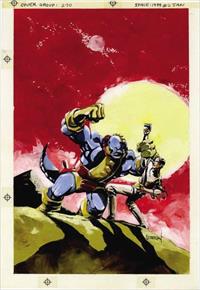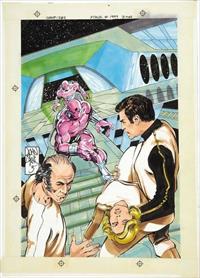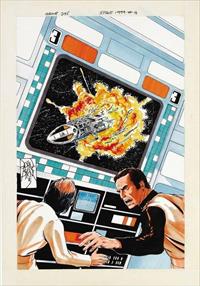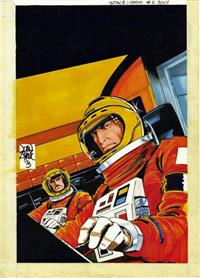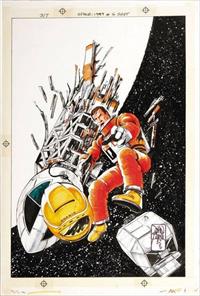Comics: Charlton Comics
Compiled by Martin Willey
See Charlton comics and the 1970s.
Note that this US comics company is not the same as the UK broadcast company Carlton, who owned the rights to Space 1999 from 1999 to 2004. Art by kind permission of Charlton Media Group.
US 1975-6, bimonthly, $1.00 each
Each 68 pages (including 10 pages of adverts -Charles Atlas, mail order, etc). 50-55 pages of art, with 3 stories of 15-20 pages (issue 1 had 4 stories), plus 3 text pieces of 2-4 pages (1 text story in issue 2, series stars/life on Alpha in issues 1, 2 & 5, all others science articles -Moon, computers, nuclear power, etc).
Editor George Wildman, art editor Gray Morrow. All cover paintings (superb colour designs of Koenig & combinations of other characters, scenes & abstract designs) by Gray Morrow. Most art by Gray Morrow, also with Adolfo Buylla, Vicente Alcazar, Pat Boyette, Dick Ayers, Carlos Pino, Ed Davis, Carl Potts, Doug Beekman and Jack Sparling. Writers Mike Pellowski, Nicola Cuti, Joe Gill.
The first covering painting was used for ITC publicity art and appeared on the HG puzzles, the Image Entertainment laserdiscs, the CEL videos in Australia and, adapted, as the wrapper art on the Donruss bubble gum packs and Collegeville Halloween costumes.
Some superb art by Morrow & Alcazar, with good likeness but very stylised equipment & sets. On the other hand, most pages were obviously rushed and some was dreadful (the quality of the printing did not help). Koenig, Victor, Helena & Alan are the heroes and most other regulars are absent. Paul appears briefly - with a beard and based on Art Editor Gray Morrow, not Prentis Hancock. The ITC license specified only the likenesses of Landau, Bain and Morse, which had to be approved by ITC. To avoid paying royalties, they were not allowed to use the features of Tate, Hancock or the other actors. The stories and art feature Carter strongly, reflecting the TV series.
Some of format seemed based on the early 1999 premise (Moon City, Com-Com), but 1999 content was generally incidental. Stories included stock science fiction adventure, supernatural horror, & frequent social conflicts. The quality ranged from indifferent to good. Morrow later became a highly regarded comic-book artist.
U S 1975-6, bimonthly.
36 pages, 11 of which are adverts. One story per issue, generally 22 pages long, plus a 2 page text story. Cover painting by the same artist who did the comic strip.
Editor George Wildman, stories by Nicola Cuti (1-5), John Byrne (6) and Mike Pellowski (7). Art by Joe Staton (1-2), John Byrne (3-6), Pat Boyette (7). Staton worked on the first two issues, before moving to The Six Million Dollar Man, replaced by Byrne as main artist. Byrne would also write the story for issue 6, "Flotsam". For the last issue, Cuti and Byrne had left Charlton, and two Charlton regulars took over, writer Mike Pellowski and artist Pat Boyette. Generally the stories were entertaining. Most stories were based away from Alpha, again with only Koenig, Helena, Victor & Alan.
Each issue contained text stories, somewhat brief and dull, added to reduce US postage rates.
Original art by John Byrne for other comics (thanks to Gordon Moriguchi).
